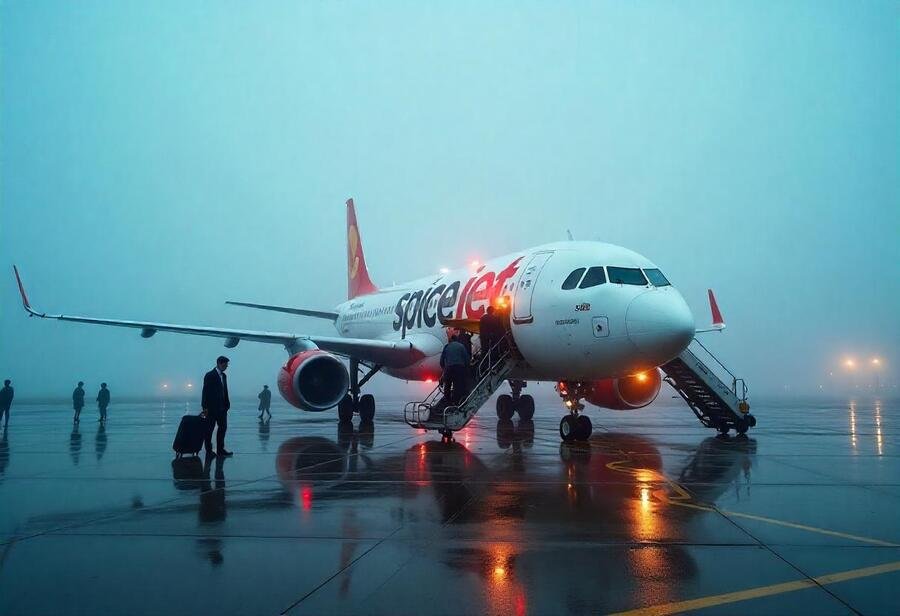Travel Guides & Articles
India Struggles With Travel Delays As SpiceJet Flight SG447 Is Cancelled After Technical Failures And Sunset Limitations At Darbhanga

Sunday, July 20, 2025
India witnessed huge travel chaos after at a destination order it for various technical and sundown restrictions at Darbhanga Airport, SpiceJet flight SG447 was cancelled. The flight, which was supposed to leave in the morning, had been plagued by problems with the aircraft. At a military-controlled airport called Darbhanga, despite being provided a replacement aircraft to troubleshoot the issue, the strict sunset restrictions led to the flight’s cancellation as it couldn’t take off on time. This latest incident raises questions about the challenges for airlines working in highly regulated airports with additional technical snafus.
On Saturday morning, passengers on SpiceJet flight SG447, originally set to travel from Darbhanga to Delhi, experienced unexpected disruptions when the flight was called off due to a mix of unforeseen circumstances technical issues and strict airport sunset restrictions.
The flight, initially set to depart at 11:40 AM, encountered delays because of technical difficulties with the aircraft. Despite efforts from the airline’s technical team, the aircraft could not be made operational on time. SpiceJet immediately arranged for a replacement aircraft to carry the passengers to Delhi. Darbhanga Airport, functioning as a military airbase, imposes stringent rules on civilian flights, including a sunset restriction that prohibits takeoffs beyond a specific time.
The replacement aircraft, although it eventually reached Darbhanga, arrived too late to secure the necessary clearance for departure before sunset. As a result, the flight was unable to take off and had to be cancelled, leaving passengers stranded at the airport. The cancellation of the flight caused significant inconvenience, as passengers had already been delayed for several hours due to the technical issues.
SpiceJet has since assured its passengers that alternative arrangements have been made. A flight has been scheduled for Sunday to accommodate those affected by the cancellation. The airline has expressed its commitment to ensuring that its passengers reach their destination as quickly as possible, despite the unforeseen circumstances.
The incident in Darbhanga follows a series of challenges faced by SpiceJet in recent weeks, underscoring the complexities of operating flights in India, particularly when strict regulations, unforeseen technical issues, and other operational challenges arise. SpiceJet has expressed regret over the inconvenience caused to passengers and has pledged to work towards minimizing such disruptions in the future.
Earlier this week, another incident occurred aboard a SpiceJet flight, this time involving disruptive passenger behavior. On flight SG9282, which was operating from Delhi to Mumbai, two passengers were offloaded after causing a disturbance by attempting to forcefully enter the cockpit while the aircraft was taxiing on the runway. Despite repeated warnings from the cabin crew, other passengers, and the flight’s captain, the two individuals refused to return to their seats, creating a highly disruptive situation onboard.
The captain of the flight, prioritizing the safety and well-being of all passengers and crew, decided to return the aircraft to the gate. The disruptive passengers were removed from the flight, and the authorities were immediately notified. They were handed over to security personnel, who took further action according to the law.
This incident highlights the importance of maintaining order and discipline on flights, especially when it comes to matters of safety. The captain, acting in the best interest of the passengers and crew, took a firm stance by making the decision to offload the disruptive passengers. In situations like these, the safety of everyone aboard remains the top priority, and crew members are trained to handle such challenges to ensure a secure and comfortable flight for all.
Both of these incidents raise important questions about the challenges airlines face when dealing with operational disruptions and passenger behavior. In the case of the flight cancellation in Darbhanga, SpiceJet had to navigate a combination of technical issues and external regulations that prevented the aircraft from departing on time. These are challenges that all airlines face, but in this case, the strict sunset restrictions at the airport played a significant role in the disruption.
SpiceJet’s handling of the disruptive passengers reflects the airline’s dedication to ensuring order and safety throughout its flights. While the actions of the passengers were unfortunate, the airline responded appropriately by offloading them and ensuring they were handed over to the authorities for further action. This establishes a clear precedent that disruptive behavior will not be accepted, reaffirming that the safety of passengers is the airline’s top priority.
Airline operations are subject to a variety of factors, both internal and external, that can affect the timely arrival and departure of flights. Technical issues with the aircraft are one such internal factor, as seen in the case of the Darbhanga flight. External factors, such as airport regulations and weather conditions, can also play a role. For example, Darbhanga Airport’s sunset restriction, which limits flight movements after a certain time, is designed to prioritize safety, particularly at airports with military or defence operations.
For passengers, the experience of a flight delay or cancellation can be highly frustrating, especially when it is caused by factors outside their control. However, airlines like SpiceJet are working to mitigate such disruptions by arranging alternative flights or accommodations to help passengers reach their destinations as soon as possible. While such events are unfortunate, they also highlight the complexities of air travel and the importance of effective communication between the airline and its passengers.
In the wake of these incidents, SpiceJet has continued to emphasize its commitment to customer service, promising to enhance its operations and minimize disruptions in the future. The airline has pledged to address the causes of the technical issues that led to the delay of the Darbhanga flight and has assured passengers that measures are being taken to ensure that such disruptions are less likely to occur in the future.
India experienced significant travel delays as SpiceJet flight SG447 was cancelled due to technical failures with the aircraft and strict sunset restrictions at Darbhanga Airport, preventing its timely departure.
The airline industry is growing and changing at a time when airlines are finding themselves facing ever more complex scenarios with technical, regulatory and weather challenges. Passenger accounts from flights like SG447 and SG9282 are a sobering reminder why it is necessary to to maintain safety, order, and open lines of communication in the event of disruption. While SpiceJet, or any airline, must remain viable in the face of such challenges, it needs to do so with a focus on passenger safety and satisfaction.
Travel Guides & Articles
Solo travel for women: Tips for vacationing alone

From mountain trekking in India to a silent retreat in Bali, I’ve been fortunate to travel solo multiple times in the past decade.
Over the years, I’ve found that mixing tours with independent travel helps me get the most out of my trips.
Meeting people is high on my priority list, as is feeling safe when I travel. Here are some tips to do both.
Cover your calves in India
In the southern state of Kerala, India, I stayed at Soul and Surf, a guesthouse in the town of Varkala that specializes in yoga classes and surfing lessons. While on the resort’s grounds on a grassy clifftop, I lazed in a bikini among mainly western tourists. But in the center of the small town, I wore long dresses or pants and made sure to cover my legs and shoulders.
I reveled in waking up solo and being able to choose exactly what I wanted to do each day.
Local people dress modestly, and it was important for me to respect that: I also felt that I would be less likely to attract unwanted attention.
Kerala has a reputation for being more relaxed than other parts of India but I still covered up. Following local customs is a good way to fit in to any destination.
Join a tour — but do your own thing too
When traveling by myself, I aim for a mix of organized tours and solo explorations. On a trip to Vietnam, I joined a sightseeing tour of the Mekong Delta, a network of rivers and islands in the southern tip of the country.
While the tour was undeniably touristy, I got the chance to chat with others and hear their stories. We had evenings to ourselves, and I enjoyed swimming alone at the hotel’s pool and eating street food for dinner by myself.
The author on a tour of an island in the Mekong Delta, Vietnam.
Lucy Handley
After the tour, I enjoyed doing my own thing on Phu Quoc, an island in the Gulf of Thailand. I reveled in waking up solo and being able to choose exactly what I wanted to do each day.
I mixed tours with solo travel on my trip to Kerala too. After a few days by the beach, I joined an organized trek of the Western Ghats from the hill town of Munnar, hiking through tea plantations, cardamom fields and rainforests, where we had to get off the beaten path so as not to disturb the area’s wild elephants.
Yoga can take you everywhere
I have attended yoga classes alone in Las Vegas, the Spanish island of Mallorca, and the tourist-friendly state of Goa, India.
A retreat at Villa De Zoysa, a family-owned estate in southern Sri Lanka, kickstarted my love of yoga, and it has helped me find community when I travel alone. For those who aren’t fans, language and dance classes could work too.
While cat-sitting in Mallorca, I joined classes at Bini Balance, run by yoga instructor Cristina Moragues. She invited me to join a retreat in the nearby Serra de Tramuntana mountain range that runs through the center of the island.
In Goa, I approached tourists who were walking on Patnem Beach, carrying yoga mats. They invited me to join a class, and we became vacation buddies, going on a boat trip to neighboring beaches and spending the evening at a silent disco together.
Sit at the bar when eating out
Dining alone can feel exposing, so I often look for restaurants where there are seats at the bar.
On a solo trip to New Orleans to see Beyonce perform during her 2023 Renaissance tour, I had brunch at Willa Jean in the city’s central business district. I sat at the bar, enjoying avocado toast and a paloma cocktail, while chatting to a private jet company operator and an LVMH executive, who were both in town for business.
Sitting at the counter or bar at a restaurant can be a good way to meet other travelers when vacationing alone.
Westend61 | Getty Images
At Bearcat, also in the CBD, there’s a large menu with breakfast classics alongside Southern crab and lobster specials, and I found sitting at the bar a good way to take in the buzzy atmosphere.
Get off your phone
Call me old school, but I love a proper travel guidebook.
I find trawling endless online reviews for hotel or restaurant recommendations tedious and instead rely on “Lonely Planet” or “Rough Guide” books. It also feels safer — I’m less likely to have my phone in my hand scrolling on an unfamiliar street. Plus, it means I look up more and can take in more of my surroundings.
Guided walking tours are also a great way to explore a city without your nose in your phone. I took a walking tour of Ho Chi Minh City with GuruWalk, which runs on a pay-what-you-can basis.
Stay in a hotel with group activities
Hotels that offer activities can make for an easy solo trip. Red Mountain Resort in Utah offers packages that include group guided hikes, classes such as Pilates, core fitness and meditation. While there, I found these activities made it easy to meet other travelers.
Guests can go on a kayak or paddleboard “safari” to an adjacent bay at Neilson’s Beach Club in Sardinia.
Source: Neilson
Meanwhile, British holiday company Neilson includes activities like cycling, tennis classes, paddle boarding and sailing in its vacations, and its social dining table can be a friendly place for solo travelers. Traveling during school terms increases your chances of meeting others who are vacationing alone — and it’s cheaper, too.
Certain activities attract solo travelers too. In Indonesia, I stayed at Bali Silent Retreat, where most guests were traveling solo. Not speaking for a few days felt liberating. However, if the silence is too much, the retreat offers short trips to a nearby hot spring, where talking is allowed.
Safety tips for solo travel
Traveling by yourself can feel hugely freeing. That said, I do take a few safety precautions.
Before I go away, I leave a detailed itinerary with my family, including the phone numbers of tour guides and taxi companies I’m using, along with my travel insurance information.
If you’re a U.S. citizen, you can register trips abroad with the government’s Smart Traveler Enrollment Program so you can be contacted if there is an emergency. There is no similar system in the U.K., but the government publishes a list of English-speaking doctors worldwide.
I book most of my transfers, accommodations and tours ahead, though I try to leave some flexibility so I can be spontaneous too.
When I’m out and about, I wear a cross-body purse and avoid keeping valuables in my pockets. I always pack a spare credit card and extra cash, which l leave in the hotel’s safe. When traveling by train, or rickshaw in India, I wore a money belt under my pants. Locals advised me not to walk alone late at night in New Orleans, and I made sure to book and wait for taxis indoors rather than on the street.
A cross-body purse is useful for valuables while traveling.
Mayur Kakade | E+ | Getty Images
When I told friends I was traveling by myself to India, some said they were concerned for my safety. But I found that when people approached me they usually just wanted to practice their English.
In Bali, meanwhile, traveling around the island is simple via the ride-hailing apps Gojek and Grab.
When it comes to accommodations, I avoid ground-floor rooms. I also utilize all locks on the doors, so that someone with a key can’t enter the room while I’m asleep.
And, I seek advice from local people, as well as other tourists, on areas to avoid or tour operators they recommend.
Finally, my best advice: trust your intuition. If a person, situation or place feels unsafe, leave or seek help.
Travel Guides & Articles
Guru Nanak’s birth aniv: Centre denies Sikh jatha permission to visit Pakistan

The Union government has refused permission to send a Sikh jatha (group of pilgrims) to Pakistan for Sikhism’s founder Guru Nanak’s Parkash Parb in November this year, citing security concerns.
The Shiromani Gurdwara Parbandhak Committee (SGPC) had started the process earlier this year in July, gathering passports of intending devotees and sending applications to the Pakistan high commission in New Delhi for the necessary visas for the 10-day pilgrimage. However, in a letter sent to the chief secretary of Punjab and other neighbouring states, the Union ministry of home affairs stated that the current security situation between India and Pakistan made it unsafe for pilgrims to travel.
{{^usCountry}}
{{/usCountry}}
“Considering the prevailing security scenario with Pakistan, it would not be possible to send the Sikh pilgrims’ jatha to Pakistan on the occasion of Sri Guru Nanak Dev Ji’s Gurparb in November 2025. We request that Sikh organisations in your state are informed and that the processing of jatha applications is stopped immediately,” reads the letter, dated September 12, sent by the under secretary of the Union ministry of home affairs to the chief secretary of Punjab and other neighbouring states.
{{^usCountry}}
The Union government’s refusal to permit the Sikh jatha follows a series of security-related travel restrictions. The SGPC was unable to send pilgrims to Pakistan for the death anniversary of Maharaja Ranjit Singh in June this year due to similar concerns.
{{/usCountry}}
{{#usCountry}}
The Union government’s refusal to permit the Sikh jatha follows a series of security-related travel restrictions. The SGPC was unable to send pilgrims to Pakistan for the death anniversary of Maharaja Ranjit Singh in June this year due to similar concerns.
{{/usCountry}}
After the Pahalgam terror attack in April this year, which claimed the lives of 26 people, the Union government tightened travel restrictions, barring Indian citizens from travelling to Pakistan through the Attari-Wagah border checkpost. In response, Pakistan suspended all SAARC Visa Exemption Scheme (SVES) visas for Indian nationals, with the exception of Sikh pilgrims.
SGPC condemns move
The decision has sparked outrage, with SGPC president Harjinder Singh Dhami condemning the government’s refusal. “This decision is an insult to the religious sentiments of Sikh pilgrims. While cricket matches are being played between India and Pakistan, pilgrims wishing to visit their religious shrines are being denied this right in the name of security,” Dhami said.
He appealed to the Union government to reconsider the decision, pointing out that the Sikh pilgrimage to Pakistan has been a long-standing tradition, with Sikh jathas visiting Pakistan for Guru Nanak’s birth anniversary for decades. “Since Partition, Indian Sikhs have been allowed to visit their religious shrines in Pakistan without interruption. This is the first time such a situation has occurred,” Dhami added.
Guru Nanak’s Parkash Gurparb is a major religious occasion for Sikhs worldwide, with many travelling to Nankana Sahib in Pakistan to pay homage at the Guru’s birthplace. The Nehru-Liaquat Pact of 1950 allows Sikh pilgrims to visit Pakistan’s sacred shrines on four key occasions — Baisakhi (Khalsa Panth foundation), Guru Arjan Dev’s martyrdom day, death anniversary of Maharaja Ranjit Singh and Guru Nanak’s birth anniversary.
In the past, thousands of Indian Sikhs have visited Pakistan for the Guru Nanak Gurpurab celebrations. In 2023, over 5,800 Indian pilgrims travelled to Pakistan’s gurdwaras to mark the Khalsa Foundation Day (Baisakhi), setting a record.
Travel Guides & Articles
Multiple Landslides Disrupt Traffic and Prompt Travel Advisory

KOHIMA- Heavy monsoon rains lashed Nagaland on Sunday, triggering multiple landslides that disrupted traffic along both National Highway-29 (NH-29) and alternative routes, prompting authorities to issue an urgent travel advisory. While no casualties have been reported, officials have cautioned residents and travelers to remain alert as the state braces for more rain in the coming days.
In Peren district, Deputy Commissioner’s office issued a public advisory warning of several landslides along the Mhainamtsi–Pimla road, an alternate route frequently used when NH-29 is blocked. Authorities confirmed that the road is currently impassable, with debris and unstable slopes posing risks of further slides.
Meanwhile, flooding from the Chathe River triggered a major landslide near Pherima village on NH-29, the crucial highway connecting state capital Kohima to the commercial hub of Dimapur. Videos shared on social media showed massive debris covering the highway, stranding vehicles and halting movement of goods.
Emergency teams, including the State Disaster Response Force (SDRF), have been deployed for clearance and restoration work. Officials recalled that this stretch witnessed a deadly landslide in September 2024, which claimed six lives, underscoring the chronic vulnerability of the route.
The Nagaland State Disaster Management Authority (NSDMA) reiterated its warnings about landslide-prone zones in the state, urging people to avoid travel on unsafe stretches, monitor official updates, and remain vigilant in hillside villages. The India Meteorological Department (IMD) has forecast continued heavy showers for the next 48 hours, raising the risk of further landslides and flash floods.
Chief Minister Neiphiu Rio’s office assured that state resources have been mobilized, and local communities will receive support. Residents in vulnerable areas have been asked to follow NSDMA’s safety guidelines, including avoiding steep slopes, watching for unusual cracks or ground movement, and preparing for possible evacuations.
-

 Business2 weeks ago
Business2 weeks agoThe Guardian view on Trump and the Fed: independence is no substitute for accountability | Editorial
-
Tools & Platforms1 month ago
Building Trust in Military AI Starts with Opening the Black Box – War on the Rocks
-

 Ethics & Policy2 months ago
Ethics & Policy2 months agoSDAIA Supports Saudi Arabia’s Leadership in Shaping Global AI Ethics, Policy, and Research – وكالة الأنباء السعودية
-

 Events & Conferences4 months ago
Events & Conferences4 months agoJourney to 1000 models: Scaling Instagram’s recommendation system
-

 Jobs & Careers3 months ago
Jobs & Careers3 months agoMumbai-based Perplexity Alternative Has 60k+ Users Without Funding
-

 Podcasts & Talks2 months ago
Podcasts & Talks2 months agoHappy 4th of July! 🎆 Made with Veo 3 in Gemini
-

 Education3 months ago
Education3 months agoVEX Robotics launches AI-powered classroom robotics system
-

 Education2 months ago
Education2 months agoMacron says UK and France have duty to tackle illegal migration ‘with humanity, solidarity and firmness’ – UK politics live | Politics
-

 Podcasts & Talks2 months ago
Podcasts & Talks2 months agoOpenAI 🤝 @teamganassi
-

 Funding & Business3 months ago
Funding & Business3 months agoKayak and Expedia race to build AI travel agents that turn social posts into itineraries

















